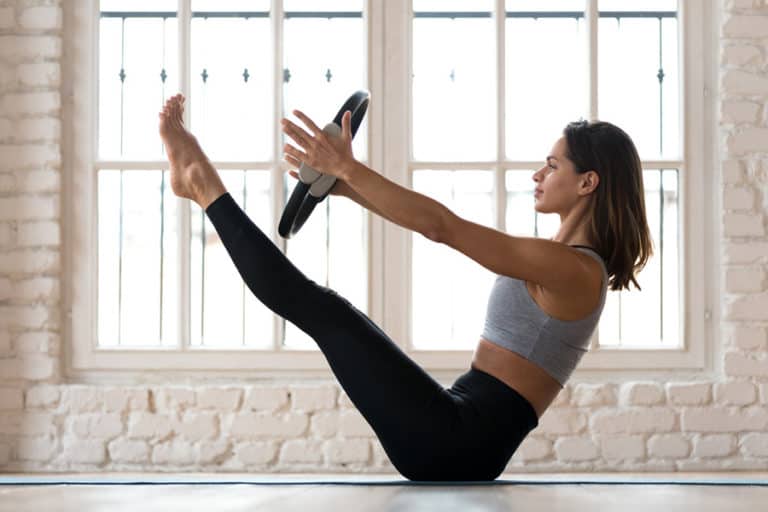Yoga for Pain Relief : Heal 6 Chronic Pains

Yoga can provide relief to people suffering from different kinds of pain. Here is a list of 6 types of chronic pains and how to do yoga for pain relief.
In recent decades, yoga has earned a steady reputation as a dependable, alternative, regenerative and pain-relief therapy. From everyday back, neck, and shoulder aches, to specific conditions such as Fibromyalgia, Osteoarthritis, and even cancer-related pain, Yoga for pain relief is regularly recommended as a complementary therapy to alleviate the sufferings of millions around the world.
In the 21st century, pain is increasingly a byproduct of our lifestyle, rather than of injuries or the natural aging process. If anything our lifestyles have speeded-up aging and worsened our tendency towards injury of the internal and external kind.
If unhealthy food habits and sedentary lifestyles weren’t bad enough, we now have jobs that confine us to our desks, keypads, and keyboards. Once the office shuts, there is always a ton of Netflixing and chilling to do on a lazy, cozy couch.
We know that a good fitness routine goes a long way in developing the body’s strength and resistance against aging, injury, and all kinds of pain. According to a study [1]National Library of Medicine: Perspectives on Yoga Inputs in the Management of Chronic Pain, yoga scores a goal as a means of pain relief due to its wholesomeness. It is a mind-body discipline at its core.
By combining breathing, stretching, and meditative exercises, yoga counters the combined effects of aging, injury, and stress. In its most common forms, Yoga exercises are gentle on the body. But, performing yoga poses with the help of a partner can reduce the risk of injury. Consequently, practitioners have much less risk of sustaining workout/yoga-related injuries that worsen pre-existing aches and pains.
Let’s look at a few forms of pain that Yoga can help alleviate and how it achieves this.
Yoga and pain perception
As the name suggests, pain perception refers to the way our minds feel the pain signals that might arise from different parts of the body. As much as we think that bodily pain is a purely absolute and physical sensation, its perceptions may be far more complicated and subjective.
How severely we feel the pain in our body, can be hugely influenced by various factors. Pre-existing physical conditions or illnesses, genetics, social or cultural factors, neurological conditions, mental states like stress and depression affect the magnitude of our pain sensations. It is also impacted by the positive or negative associations that get attached to a particular form of pain.
Yoga can help decrease pain perception in people. As a holistic mind-body discipline yoga has the power to attack both the physical sources of pain and the mental elements that might be worsening it.
For example, yoga may contribute to the reduction of stress, depression, anxiety, or panic attacks. Its calming practices can also help dissociate negative emotions attached to the pain. If you wish to try yoga for pain relief, consult an expert on what poses and practices might work on the physical and mental aspects of your pain. Gentle formats like yin yoga and stress relieving, calming practices like meditation, and Yoga Nidra will slowly but surely reduce your pain.
Yoga for neck pain relief
The neck, back, and shoulders have a notoriety for being the most affected by physical and mental stress. The back of your neck(nape) is a particularly sore point. The neck is a strategically located joint that connects the brain with the spine. Additionally, it is also linked to the arms/hands(most worked organs in the body).
Any strain on the arms, shoulders, back or the brain automatically shows up as catches, spasms, or pain in the neck. The nape is where the body’s collective stress gets accumulated. A farmer bent over the fields all day, a desk-bound techie, or an indefinitely stressed homemaker, are all equally prone to neck pain.
Studies suggest that regular practice of yoga can provide relief from neck pain and improve flexibility and mobility in the neck. Certain yoga poses like the puppy pose and the bow pose stretch relax tensed neck muscles. Breathing and meditative exercises like Pranayama, Yoga Nidra, and the corpse pose to release the accumulated mental stress as well.
Unless your neck pain is a result of a more serious injury or trauma, yoga might be an effective source of relief for any neck pain. Be sure to consult a certified expert before you start yoga for neck pain relief.
Yoga for shoulder pain relief
Shoulder muscles can be adversely affected by heavy lifting, bad posture, continuous hunching, strain on hands or neck, and stress. The shoulder blades are sensitive to short-term stress situations too. Most people unwittingly tense their shoulder muscles when faced with sudden stress situations.
It is very important to keep stretching, relaxing, and exercising one’s shoulder muscles regularly. Yoga poses like puppy pose, cat pose, and plow pose help to stretch out and strengthen muscles around the shoulder region. Additionally, yoga can considerably improve one’s posture, thereby reducing everyday stress on these muscles.
Yoga for back/lower back pain relief
Do you happen to slouch when you walk and hunch when you sit? How about when you stand. Look around you, you will find very few people who sit, stand, or walk with an erect posture.
Poor posture is the primary culprit behind most backaches. Lack of sleep hygiene(the ergonomics of your beds and pillows, sleep positions, stress during sleep) might be an added factor.
Women are the major victims of the human back and the way it has evolved. Their reproductive, menstruating, and childbearing bodies paid a heavy price for the evolution from bent apes to erect homo sapiens. There is hardly a post-puberty woman who hasn’t at some point in life dealt with backaches.
Factor in the Trans community of people whose bodies live the same lifestyles and back-pain inducing biologies to the demographic. Back/lower-back pain is a humungous problem.
Yogic stretches are famous for relaxing, even lengthening the back. One guaranteed benefit of yoga is automatic improvements in posture. Yoga’s beneficial effects on pregnant and menstruating bodies are universally acknowledged now.
For pregnancy-related lower back pain try the cat-cow pose, open seated-twist pose, mountain pose, or downward dog pose.
The corpse pose, butterfly pose, reclining twist pose, can considerably alleviate menstrual back pain and cramps.
For people with chronic back [2]Beaumont: Benefits of Yoga for Pain Management pain, the cobra pose, sphinx pose, locust pose, and corpse poses can be of great help.
Always remember that the lesser the stress, the lower your chances of having backaches. The spine, after all, is directly connected to your brain and the expressway of your body’s neural networks.
Relax your breath with some pranayama and meditate in the lotus pose or the corpse pose. It will go a long way in keeping your back healthy, happy, and pain-free.
Yoga for hip pain relief
Hip pain may be a result of arthritis, fractures, straining, or inflammation of the muscles and tendons around this region. Other causes include low blood flow to the region, endometriosis in the uterus, or even cancer.
Regular practice of yoga can keep the muscles supple, reduce inflammation, and keep the blood flow healthy. Yoga poses require the body to move and stretch the supporting muscles around the hip region. This increases the strength of those muscles, thereby reducing the incidence of hip pain.
One of the simplest yoga poses you can try for chronic hip pain is the yoga squat. The boat pose, big-toe pose, cat pose, and child’s pose may also help to reduce hip pain over time.
Yoga for pain relief – headaches
If you are prone to migraines or sinusitis, yoga might be beneficial for you. Migraines are very often associated with poor circulation, nervous health issues, or stress. Sinus can be a result of colds or allergies.
While there is no conclusive evidence [3]National Center for Complementary and Integrative Health: Yoga for Pain: What the Science Says for the usefulness of yoga in relieving headaches, it might still be of help. We do know about yoga’s effects on stress. It also aids healthy blood circulation. Consequently, it might help to keep migraine headaches at bay.
Practice breathing exercises like pranayama and neti-pot cleansing to clear the sinuses. This will prevent the swelling and blockage of the sinuses which cause those painful sinus-triggered headaches.
Yoga for arthritic/knee-pain relief
Most knee pains are a result of natural wearing away of the bones around this joint(osteoarthritis). The straining and inflammation of muscles around the knee joint are other common causes, found a study. Given that the knees are central to our movement, they are also prone to a lot of external injuries as well.
Yoga can reduce the inflammation of muscles. It can also strengthen the surrounding muscles in the region. A healthy posture aided by regular practice of yoga will reduce the everyday pressure on the knee joints.
Try the modified hero pose, bound angle pose and the extended triangle pose to stretch, relax and strengthen the knee joints.
A word of caution
Yoga can be a boon to people suffering from various forms of pain. Several studies have shown that yoga may alleviate pain in some cases, and reduce pain perception levels in general. But, caution should be exercised while choosing to opt for yoga for pain relief.
Yoga is a complementary therapy, not a primary line of treatment. Even so, it is a slow and long-term therapy at best. There is not enough high-quality evidence to prove that yoga can singularly cure any form of pain.
The problem with an ancient discipline turning into a fad is twofold. Firstly people assume that it is a cure-all. Secondly, people often rush into it.
Yoga needs to be practiced both with patience and great precaution. This is especially true if your pain is a result of serious injury or serious health conditions. In such cases, you will need the recommendations of a qualified doctor and the guidance of a certified trainer.
Remember that yoga doesn’t always work directly on the immediate problem. For instance, if your pain is a result of a serious condition such as fibromyalgia or cancer, yoga helps by reducing your pain perception. It does not cure the preexisting condition.
Yoga is primarily a mind-body exercise discipline. It aims for holistic health and healing, rather than quick-fix remedies for health issues.
References
| ↑1 | National Library of Medicine: Perspectives on Yoga Inputs in the Management of Chronic Pain |
|---|---|
| ↑2 | Beaumont: Benefits of Yoga for Pain Management |
| ↑3 | National Center for Complementary and Integrative Health: Yoga for Pain: What the Science Says |


